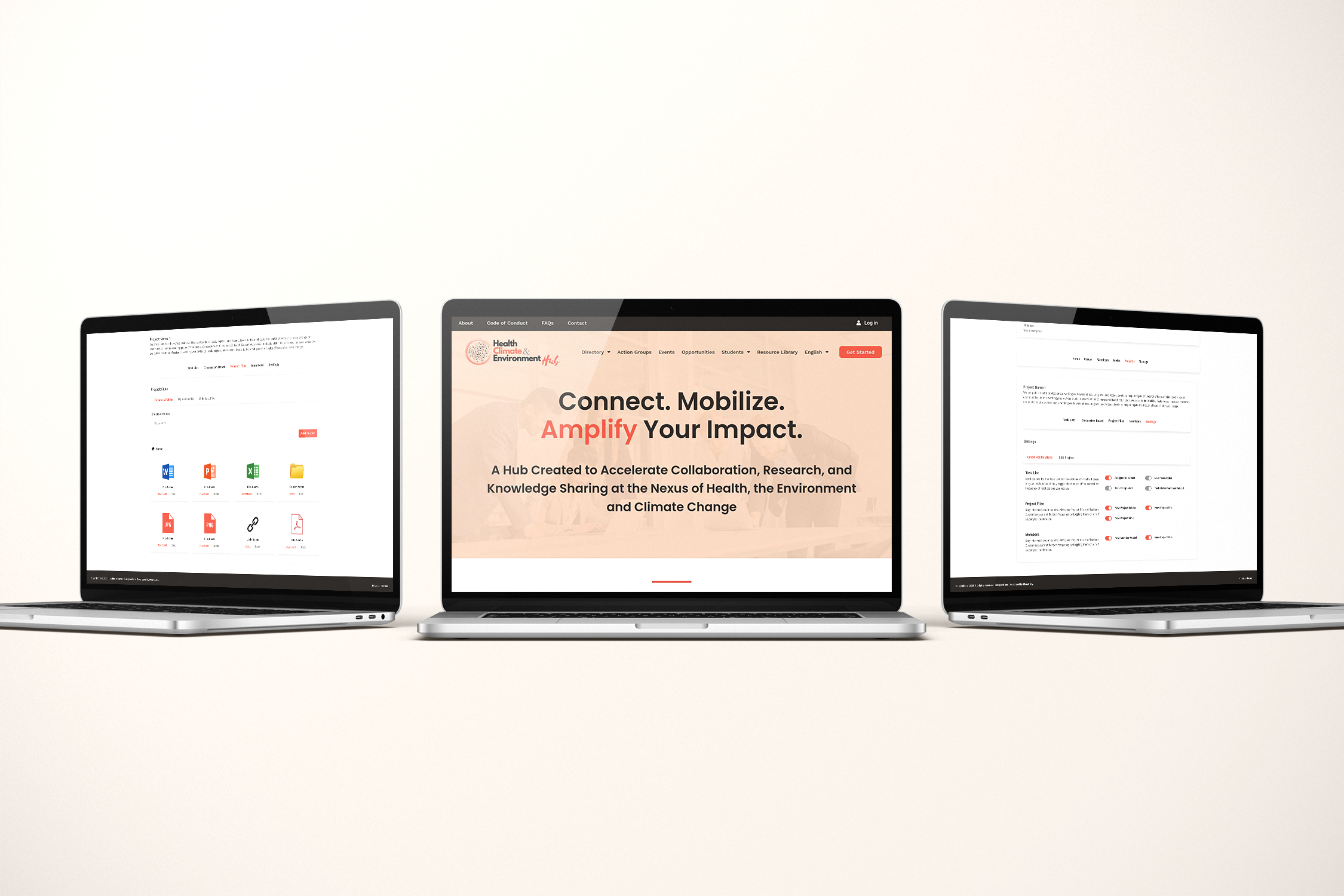Case Study
Climate Resources for
Health Education
Responsive website for peer-reviewed climate and health resources
Project Overview
Project Scope
Tools
Stakeholders
Duration
Role
Project Scope
Tools
Stakeholders
Duration
Role
Background
The Climate Resources for Health Education (CRHE) case study focuses on the UX design process undertaken to create a user-centered and responsive website for peer-reviewed climate and health resources. CRHE aims to provide educators and health professionals with easy access to reliable information and tools that integrate climate change and health education into their curricula and practice. The project began with a comprehensive understanding of the target audience, including educators, researchers, and professionals in the field of climate and health. Extensive research was conducted to identify their needs, frustrations, and motivations, which formed the foundation for developing user personas and empathy maps. These insights guided the design process, ensuring that the website addressed specific user goals and challenges.
The UX design process for CRHE involved various stages, including information architecture, wireframing, prototyping, and usability testing. A collaborative approach was adopted, involving stakeholders and subject matter experts to gather valuable input and ensure alignment with project objectives. Throughout the process, the design team prioritized accessibility, usability, and content reliability. Design decisions were informed by industry best practices and competitor analysis, with a focus on creating a visually appealing and intuitive interface that supported the seamless exploration and utilization of resources.
The resulting website offers a well-organized content hierarchy, clear task flows, and user-friendly features that facilitate resource discovery, collaboration, and knowledge sharing. The project showcases the importance of integrating user-centered design principles and research insights into the development of a comprehensive and impactful online platform. This case study delves into the UX design process for CRHE, highlighting the methodologies, tools, and strategies employed to create a user-centered solution. It demonstrates the value of applying a human-centric approach to design, emphasizing the significance of considering user needs, motivations, and frustrations to develop a successful digital product.
Challenges
Complex Content Organization: The website aims to provide evidence-based resources related to climate change and planetary health. The challenge lies in organizing and presenting this vast amount of complex information in a user-friendly and easily digestible manner. Careful consideration needs to be given to information architecture and navigation to ensure users can find the resources they need efficiently.
Targeting Diverse Audiences: The CRHE website caters to a wide range of audiences, including health professionals, educators, and students. Each group may have different levels of expertise and information needs. Designing a user experience that caters to this diverse audience while still providing a coherent and intuitive interface can be a challenge.
Accessibility: The website should be designed to be inclusive and accessible to all users, including those with disabilities. Providing alternative text for images, ensuring proper color contrast, and adhering to accessibility guidelines are crucial considerations.
Multilingual Support: Since the initiative is global, there may be a need to provide multilingual support to reach a broader audience. This presents a challenge in terms of translating content, maintaining consistency across languages, and designing a scalable solution for future translations.
Integration of Cutting-Edge Science: The website aims to translate the latest scientific research into practical resources for health practice. Keeping up with the ever-evolving research and ensuring timely updates to the website can be challenging. The design should accommodate frequent content updates and provide a seamless experience to users.
Objectives
- Design a responsive resource directory website for CRHE.
- Develop and extend coherent branding that aligns with the CRHE target audience.
Design Process
From Concept to Creation
Hypothesis
Strategy
Build
Discover
Discover
Define
Develop
Deliver
Discover
- Requirement Analysis
- Stakeholder Interview
- User Feedback Analysis
- Iterative Design Improvements
- A/B Testing and Experimentation
- Optimization
Research Plan
Discover
Research allows me to understand users on a deeper level, considering their frustrations, hopes, fears, abilities, limitations, reasoning, and goals. It provides the necessary groundwork for effective solutions. To maintain research focus and guide responsive website design, I create a research plan at the beginning of each project. It includes research goals, questions, assumptions, methodologies, participants, and the project timeline.
Research Goals
- Understand the information needs and preferences of the target audience for CRHE website.
- Identify the usability challenges and pain points users may encounter when accessing and navigating a climate change and health education website.
- Gain insights into how users perceive the credibility and trustworthiness of the CRHE initiative and the collaborating institutions.
- Explore the expectations and preferences regarding brand identity and design aesthetics for a climate change and health education website.
- Identify opportunities for innovation and gather feedback on potential features and functionalities for the CRHE website.
Research Questions
- What specific information do health professionals, educators, and students seek regarding climate change and planetary health education resources?
- What are the key usability challenges users face when accessing and navigating existing climate change and health education websites?
- How do users perceive the credibility and trustworthiness of initiatives related to climate change and health education?
- What are the expectations and preferences regarding brand identity and design aesthetics for a climate change and health education website?
- What features and functionalities would users find most valuable and effective in a climate change and health education website?
Assumptions
- The target audience for CRHE, including health professionals, educators, and students, are motivated to incorporate climate change and planetary health information into educational curricula.
- Existing climate change and health education websites may have usability issues and may not fully meet the needs of the target audience.
- Collaborating institutions (GCCHE, MGH, BWH, UCSF, and Emory University School of Medicine) lend credibility and authority to the CRHE initiative.
- The brand identity and design aesthetics of the CRHE website should resonate with the target audience and align with their expectations and values.
Methodologies
Market Research: Conduct an analysis of the existing landscape of climate change and health education resources to identify trends, gaps, and potential opportunities.
Competitive Analysis: Evaluate similar websites or initiatives in the field of climate change and health education to understand their strengths, weaknesses, and innovative features.
User Interviews: Conduct qualitative interviews with health professionals, educators, and students to gather insights into their information needs, preferences, challenges, and perceptions related to climate change and health education resources.
Prototype Testing: Develop interactive prototypes or wireframes of the CRHE website and conduct user testing sessions to gather feedback on usability, design aesthetics, and features.
Expert Evaluation: Engage domain experts in climate change, health education, and user experience to evaluate the content, structure, and design of the CRHE website.
Participants
Participants for the research activities can include:
- Health professionals (e.g., doctors, nurses, public health experts)
- Educators (e.g., teachers, professors, curriculum developers)
- Students (from various educational levels, including medical and health-related disciplines)
- Domain experts in climate change and health education
Project Timeline
Tasks
Timeframe
Market Research
Discover
Market Trends
Increasing Global Awareness: There is a growing recognition of the impact of climate change on human health and the need for education and resources to address this issue effectively.
Source: American Public Health Association
Digital Transformation: The use of digital platforms for education, collaboration, and knowledge sharing has become more prevalent, enabling wider access to resources, and fostering global connections.
Source: Harvard Business Review
Interdisciplinary Collaboration: There is a trend towards interdisciplinary collaboration among health professionals, educators, researchers, policymakers, and communities to address the complex challenges of climate change and health. Source: The Lancet
Demographics
Broad Target Audience: The target audience for CRHE includes health professionals, educators, students, policymakers, and community members interested in climate change and health education.
Global Reach: CRHE aims to have a global impact, engaging individuals and organizations from diverse geographic locations and cultural backgrounds.
Trends and Considerations
Accessibility: Ensuring the website is accessible to all users, considering factors such as usability, inclusivity, and support for assistive technologies. Source: Web Content Accessibility Guidelines (WCAG)
User Engagement and Motivation: Design strategies should be employed to encourage active user engagement, such as gamification elements, incentives, and personalized experiences, to foster sustained participation and contributions.
Consumer Behavior
Knowledge Sharing and Learning: Users are driven by the desire to access up-to-date resources, collaborate, and gain knowledge from subject matter experts and researchers to make informed decisions and act. Source: Forbes
Collaboration and Networking: Users value opportunities to engage in collaborative projects, propose initiatives, connect with like-minded individuals, and build networks to drive positive change. Source: Asana
Emphasis on Impact: Users are motivated by the opportunity to contribute to tangible improvements in health, environment, and climate outcomes, aligning with their personal values and goals.
Source: Centers for Disease Control and Prevention
Competitive Analysis
Discover
It is important to research other website in the climate resources space in an effort to gather insights about their strengths and weaknesses. These insights also help me identify any gaps in features that the Hub might address. I analyzed 3 direct competitors as shown below, who provide similar climate and health resources.

EnviroHealth Solutions
EnviroHealth Solutions is a leading platform that provides a comprehensive directory of evidence-based resources on climate change and health education. Their focus is on offering in-depth research papers, case studies, and policy guidelines to support professionals in incorporating climate change considerations into health curricula.
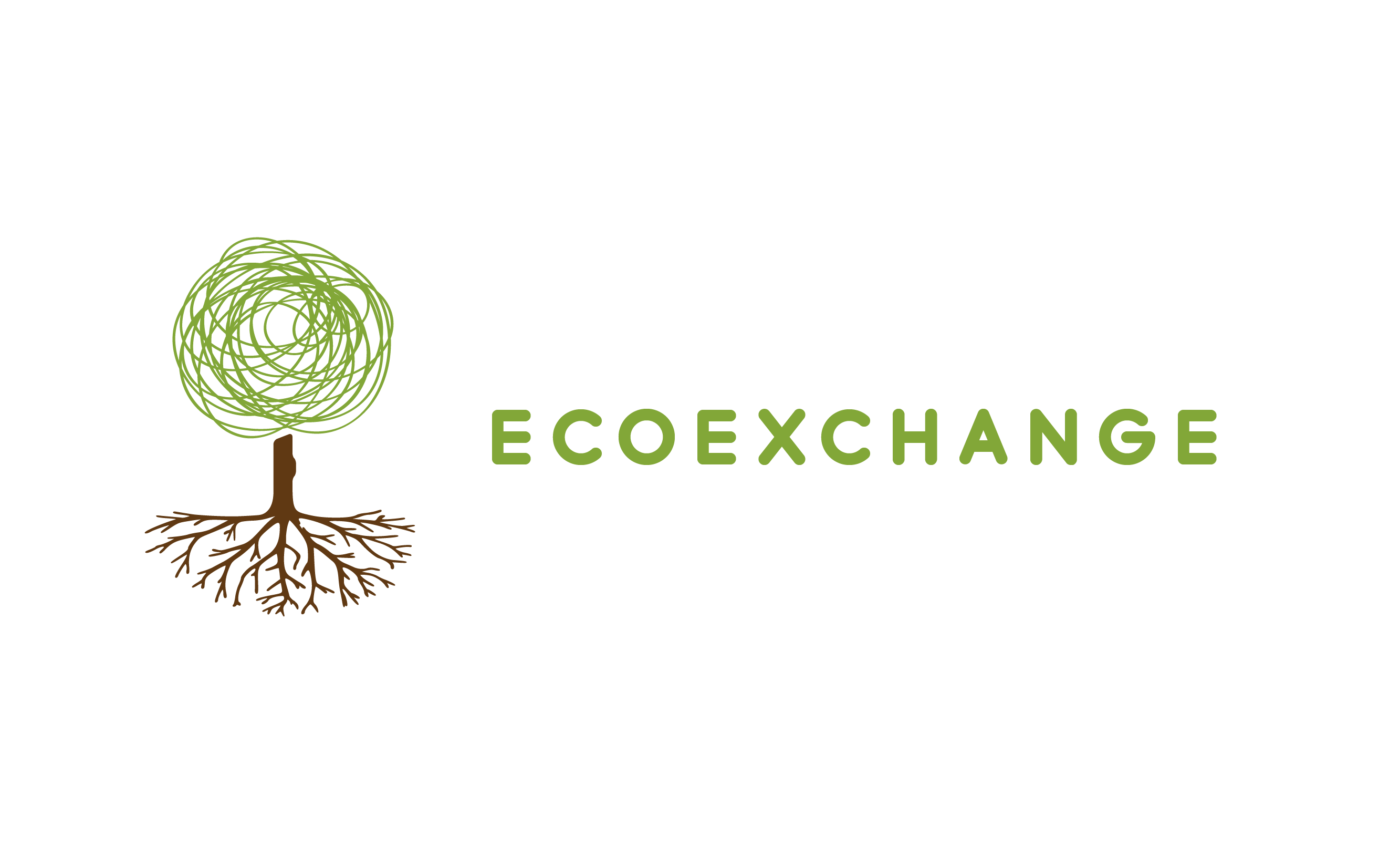
EcoExchange
EcoExchange is an online community-driven platform dedicated to climate change and health education. It provides a range of resources, including interactive modules, webinars, and discussion forums, aiming to facilitate collaboration and knowledge exchange among health professionals, educators, and students.
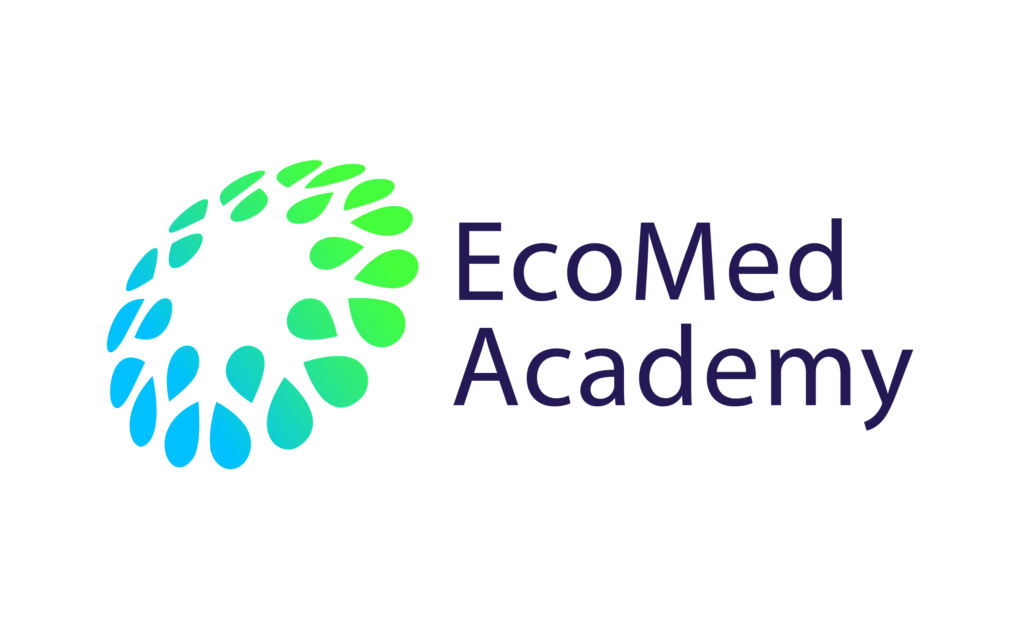
EcoMed Academy
EcoMed Academy is an innovative online learning platform that combines climate change and health education through immersive technology. They offer virtual reality simulations, interactive courses, and data visualizations to provide engaging and impactful learning experiences for health professionals and students.
Strengths
Extensive Resource Library: EnviroHealth Solutions offers a vast collection of up-to-date resources across various disciplines, ensuring a comprehensive coverage of climate change and health topics.
Global Collaborative Network: They have established partnerships with renowned universities, research institutions, and international organizations, enabling them to provide diverse perspectives and expertise.
User-Friendly Interface: EnviroHealth Solutions prioritizes a seamless user experience with intuitive navigation, advanced search filters, and personalized recommendations for easy resource discovery.
Strengths
Engaged Online Community: EcoExchange has fostered a vibrant and active community of users who actively contribute resources, engage in discussions, and share best practices.
User-Centric Design: Their website focuses on user-friendliness, ensuring a seamless experience for users to access and navigate resources, join discussions, and participate in educational programs.
Customizable Learning Paths: EcoExchange offers personalized learning paths based on users’ interests and expertise, allowing them to access tailored content that aligns with their specific needs.
Strengths
Cutting-Edge Technology Solutions: EcoMed Academy leverages virtual reality, interactive simulations, and data visualizations to enhance learning experiences and provide a deeper understanding of the connections between climate change and health.
Strong Thought Leadership: They are recognized as a leading authority in the field, actively contributing to research, conducting studies, and publishing thought leadership content.
Targeted Content for Different Audiences: EcoMed Academy delivers customized content for diverse user groups, catering to the specific needs and interests of health professionals, educators, and students.
Weaknesses
Limited Outreach to Non-Health Professionals: Their platform primarily targets health professionals and educators, potentially limiting engagement from other stakeholders, such as policymakers or community members.
Resource Updates: While they maintain a strong library, occasional delays in updating resources may result in some outdated content.
Minimal Interactive Features: EnviroHealth Solutions’ platform currently lacks interactive features or community-driven elements that could foster more engagement and collaboration among users.
Weaknesses
Limited Resource Variety: While they provide a valuable collection of resources, EcoExchange may have gaps in certain specialized areas or lack in-depth coverage on specific topics.
Integration Challenges: Their platform currently faces integration challenges with external educational platforms, potentially limiting seamless user experiences and collaborations with other institutions.
Inconsistent Updates: EcoExchange occasionally experiences delays in updating content and resources, leading to potential gaps in availability of the latest information.
Weaknesses
High Resource Requirements: Utilizing virtual reality and interactive simulations may require users to have access to specific hardware or devices, limiting the accessibility for individuals who do not have the necessary equipment or resources.
Cost Considerations: Due to the implementation of advanced technology solutions, EcoMed Academy has subscription fees and additional costs associated with accessing certain immersive experiences or specialized courses, potentially limiting access for users with limited budgets or financial resources.
Provisional Personas
Discover
Using the data from market research, I created provisional personas to represent potential users of CRHE. These personas, based on statistical knowledge, will assist me in identifying suitable individuals for interviews and understanding their needs.

Name
Public Health Powerhouse
Description
Public Health Professional
Age Range
30-39
Lifestyle
- Leads a busy life, juggling work commitments, community engagements, and personal interests.
- Highly motivated, constantly seeking opportunities to expand their knowledge and contribute to positive change.
Goals
Incorporate Climate Change in Curricula: They want to find evidence-based resources that can help integrate climate change and planetary health information into educational curricula, especially for schools and community programs.
Stay Up to Date: Their goal is to stay informed about the latest research, policies, and best practices in climate change and health education to enhance their professional expertise and effectiveness.
Pains
Time Constraints: They struggle with limited time to conduct comprehensive research and identify trustworthy resources, often feeling overwhelmed by the amount of information available.
Lack of Centralized Platform: They find it challenging to navigate through various websites, databases, and publications to find relevant resources, wishing for a centralized platform that offers curated and reliable content.

Name
Health Whiz
Description
Medical Student
Age Range
20-29
Lifestyle
- Full-time student, balancing academics, clinical rotations, and extracurricular activities.
- Tech-savvy, always connected to the latest digital tools and platforms to enhance their learning experience.
Goals
Accessible Learning Resources: They seek easily accessible and user-friendly resources that provide practical insights on incorporating climate change considerations into medical practice and patient care.
Networking and Collaboration: They want to connect with other students, educators, and practitioners who share their passion for climate change and health to exchange ideas, collaborate on projects, and initiate local initiatives.
Pains
Overwhelmed by Information: They often feel overwhelmed by the vast amount of information available on climate change and health, struggling to identify reliable sources and resources that align with their specific needs and interests.
Limited Integration in Medical Curriculum: They face challenges in finding resources that directly integrate climate change and planetary health into their medical curriculum, feeling a lack of emphasis on these critical topics.

Name
Learning Luminary
Description
Medical Education Specialist
Age Range
35-45
Lifestyle
- They are a dedicated educator working in a medical or health-related field.
- They hold a leadership position in a medical school or health institution and are responsible for curriculum development and instructional design.
- They lead a busy life, balancing teaching responsibilities, administrative tasks, and engaging in professional development activities.
Goals
Integrating Climate Change in Medical Education: They aim to incorporate climate change and planetary health topics into the medical curriculum to educate future healthcare professionals about the intersection of climate change and human health.
Engaging and Effective Teaching: They strive to create engaging and effective educational experiences for their students by incorporating interactive learning activities, case studies, and evidence-based resources related to climate change and health.
Pains
Limited Time and Resources: They face time constraints in developing and updating the curriculum, and they may have limited access to specialized resources and training related to climate change and health education.
Resistance to Change: They may encounter resistance from other faculty members or institutional barriers when trying to introduce new topics or revise the curriculum to include climate change and planetary health.
Keeping Up with Evolving Science: They find it challenging to stay updated with the latest research and best practices in the field of climate change and health, as the knowledge base is rapidly evolving.
User Interviews
Discover
To truly understand our users and gain direct insights, I conducted user interviews as part of primary research. I asked participants 13 open-ended questions, encouraging them to share their experiences and stories. This helped establish a real connection with our users and gather valuable insights.
There was a total of 6 participants from a variety of backgrounds were interviewed.
Interview Questions
Assumptions Validated
Assumption
Validation
Empathy Map
Discover
Insight
Need
User Personas
Discover
Understanding the audience is a crucial aspect of the UX design process for CRHE. By gathering extensive knowledge about the audience, including their goals and needs, user personas were created to represent key audience segments. These personas serve as fictional yet realistic representations of the target users, enabling the design team to focus on addressing the most important problems and fulfilling the major needs of the most significant user groups.

Name
Sophia Chen
Age
34
Occupation
High School Science Teacher
Marital Status
Married
Location
Boston, Massachusetts
Archetype
Educator Advocate
Sophia leads a busy life, juggling work commitments, community engagements, and personal interests. As a passionate educator, she spends time researching and developing innovative teaching approaches. She attends workshops and conferences related to climate change education to enhance her professional knowledge and network with like-minded individuals. Sophia also enjoys outdoor activities and actively participates in local environmental initiatives.
Goals
Incorporate Climate Change in Curricula: Sophia wants to find evidence-based resources that can help integrate climate change and planetary health information into educational curricula, especially for schools and community programs.
Stay Up-to-Date: Sophia’s goal is to stay informed about the latest research, policies, and best practices in climate change and health education to enhance her teaching effectiveness.
Frustrations
Limited Time: Sophia faces time constraints due to her teaching responsibilities, making it challenging to research and develop comprehensive curriculum materials.
Lack of Centralized Platform: Sophia finds it difficult to navigate through various websites, databases, and publications to find relevant and reliable resources.
Needs
Accessible Resources: Sophia needs easily accessible and user-friendly resources that provide practical insights on incorporating climate change into curricula.
Collaboration Opportunities: Sophia seeks platforms that facilitate collaboration and networking with other educators and professionals in the field.
Motivations
- Making a positive impact on students’ understanding of climate change and health
- Shaping environmentally conscious individuals
- Contributing to a sustainable future

Name
Linda Hamilton
Age
40
Occupation
Community Health Educator
Marital Status
Divorced
Location
Seattle, Washington
Archetype
Change Agent
Linda is dedicated to her role as a community health educator, actively involved in developing curriculum materials, conducting research, and organizing field trips to enrich her students’ learning experiences. She frequently attends conferences and workshops to stay updated on the latest advancements in climate change and health education. In her free time, Linda enjoys outdoor activities and volunteers for local environmental organizations.
Goals
Engaging Educational Resources: Linda seeks engaging, age-appropriate, and scientifically accurate resources to teach her students about the impact of climate change on health and inspire them to act.
Collaboration Opportunities: Linda wishes to connect with other educators, researchers, and professionals to exchange ideas, share lesson plans, and collaborate on developing innovative teaching approaches.
Frustrations
Limited Time for Resource Development: Linda faces time constraints in developing comprehensive teaching materials that incorporate climate change and health topics, often relying on fragmented or outdated resources.
Keeping Up with Evolving Science: Linda struggles to stay up to date with the rapidly evolving research and best practices in climate change and health education.
Needs
Accessible Resources: Linda needs resources that are easily accessible and provide engaging, age-appropriate content on the impact of climate change on health.
Collaboration Tools: Linda seeks platforms that facilitate collaboration and networking with other educators and professionals in the field of climate change and health education.
Motivations
- Linda’s passion for empowering individuals and communities drives her to make a positive impact on their health and the environment.
- She believes that education is a powerful tool for fostering positive behavioral changes and addressing climate-related health challenges.
- Linda is motivated by the opportunity to inspire her students and instill in them a sense of responsibility towards their own well-being and the planet.

Name
James Kingsford
Age
58
Occupation
Public Health Officer
Marital Status
Married
Location
New York City, New York
Archetype
Visionary Leader
Sophia leads a busy life, juggling work commitments, community engagements, and personal interests. As a passionate educator, she spends time researching and developing innovative teaching approaches. She attends workshops and conferences related to climate change education to enhance her professional knowledge and network with like-minded individuals. Sophia also enjoys outdoor activities and actively participates in local environmental initiatives.
Goals
Policy Development: James aims to influence public health policies and initiatives that address the health impacts of climate change and promote sustainable practices.
Advocacy and Awareness: James seeks to raise awareness about the connections between climate change and health among policymakers, community leaders, and the public.
Frustrations
Limited Buy-in: James faces challenges in getting stakeholders to recognize the urgency and importance of integrating climate change considerations into public health policies and practices.
Resistance to Change: James encounters resistance from individuals and organizations who are hesitant to embrace sustainable practices or allocate resources to address climate-related health issues.
Needs
Research and Evidence: James requires access to research and evidence that demonstrates the health impacts of climate change, as well as the effectiveness of interventions and policies.
Collaboration and Networking: James seeks opportunities to collaborate and network with other public health officials, researchers, and policymakers working on climate change and health-related initiatives.
Motivations
- James is driven by his vision of a healthier and more sustainable future.
- He strongly believes that addressing climate change is essential for protecting public health and creating resilient communities.
- James is motivated by the opportunity to contribute to positive change by promoting awareness, education, and action on climate change and its impact on health.
- He is passionate about advocating for policies and practices that prioritize the well-being of both individuals and the planet.
Statements and Questions
Define
Insight
Need
POV Statement
HMW Question
Participants express concerns about the lack of emphasis on climate change and planetary health in current educational curricula
Participants need easily accessible and user-friendly resources that provide practical insights on integrating climate change into curricula
Educators and health professionals seek an integrated platform that addresses the knowledge gaps in existing curricula and provides easy access to evidence-based resources on climate change and planetary health.
How might we create a centralized and user-friendly platform that offers educators and health professionals practical resources to seamlessly integrate climate change topics into their curricula?
Participants feel motivated and passionate about incorporating climate change and health education into their teaching
Participants express a need for platforms that facilitate collaboration and networking with other educators and professionals in the field
Educators and health professionals are eager to connect with like-minded individuals and share knowledge, seeking a collaborative platform that fosters networking and resource-sharing opportunities.
How might we develop a networking and collaboration feature that enables educators and health professionals to connect, exchange ideas, and share best practices in integrating climate change education into their teaching?
Participants express frustration and overwhelm due to limited time, resources, and support available for curriculum integration
Participants desire resources that can be customized to align with different educational settings and target audiences
Educators and health professionals face challenges in integrating climate change education due to time constraints and varying educational contexts, requiring flexible and customizable resources.
How might we design adaptive and customizable resources that cater to diverse educational settings and allow educators and health professionals to tailor content based on their specific audience needs and available resources?
Participants believe that integrating climate change topics can help create a more comprehensive understanding of health and prepare future professionals to address related challenges
Participants emphasize the importance of having access to accurate, evidence-based information that reflects the latest research and best practices
Educators and health professionals value evidence-based information and seek a reliable platform that offers the latest research and best practices on climate change and its impact on health.
How might we curate and verify content on the platform to ensure educators and health professionals have access to accurate, peer-reviewed, and up-to-date information that aligns with the latest research in climate and health?
Brainstorming Sessions
Define
HMW Question 1
Session 1
Session 2
- Create a searchable database of peer-reviewed articles, lesson plans, and teaching materials on climate change and health.
- Collaborate with subject matter experts and educators to curate a collection of climate change case studies and real-world applications for classroom use.
- Develop interactive multimedia content, such as videos and simulations, to engage students in climate change education.
- Offer professional development webinars and workshops for educators to enhance their knowledge and teaching strategies on climate change topics.
- Introduce a gamification element to incentivize educators and health professionals to explore and use various resources.
- Implement a user-friendly interface with intuitive navigation to easily access and filter resources based on subjects and grade levels.
- Provide a personalized dashboard for educators and health professionals to save and organize their favorite resources and share them with their networks.
- Integrate a discussion forum or community chat feature to encourage peer support and knowledge exchange among users.
- Include a feature that allows users to track their progress and receive recommendations for further resources based on their interests.
- Implement a feedback mechanism for users to rate and review resources, ensuring quality and relevance.
HMW Question 2
Session 1
Session 2
- Create a user profile with a portfolio of educators’ achievements, expertise, and interests in climate change education.
- Integrate a messaging system that facilitates direct communication between users for knowledge exchange and resource sharing.
- Develop a resource-sharing platform where educators can upload and share their lesson plans, teaching materials, and success stories related to climate change education.
- Enable users to create and join virtual events, workshops, and networking opportunities for professional development in climate and health education.
- Implement a recognition system that acknowledges and celebrates exemplary contributions to climate change education within the community.
- Incorporate a group creation feature, allowing educators and health professionals to form communities based on shared interests or locations.
- Implement a live webinar or conference feature for real-time discussions and presentations on climate change topics.
- Introduce a mentorship program that pairs experienced educators with those seeking guidance and support in integrating climate change topics.
- Offer a collaboration space for users to co-create and collaborate on innovative climate change educational projects.
- Provide integration with existing professional networks and organizations to expand networking opportunities for users.
HMW Question 3
Session 1
Session 2
- Create a resource customization tool that allows users to modify the content, format, and language of resources to suit different educational settings.
- Offer resources in various formats, such as downloadable PDFs, interactive websites, and slide decks, to accommodate different teaching preferences.
- Develop a feedback mechanism that enables users to suggest improvements or adaptations to existing resources.
- Include a resource rating system based on user feedback to identify the most effective and adaptable resources.
- Implement a localization feature that allows educators to translate resources into different languages for global accessibility.
- Integrate a curriculum mapping feature that aligns climate change resources with existing educational standards and frameworks.
- Provide a content recommendation engine that suggests personalized resources based on user preferences and past usage.
- Implement an offline mode for accessing resources in regions with limited internet connectivity or access to digital devices.
- Collaborate with educators from diverse backgrounds to co-create culturally relevant and inclusive resources.
- Provide guidance and toolkits on how to adapt resources for specific educational levels, subject areas, and target audiences.
HMW Question 4
Session 1
Session 2
- Collaborate with reputable academic institutions and organizations to ensure content verification and peer review.
- Implement a content moderation feature that allows users to report and flag questionable or outdated resources.
- Establish a content review committee comprising subject matter experts to assess and validate resources regularly.
- Offer a content accreditation system that highlights resources from reputable sources and peer-reviewed journals.
- Integrate an automated content verification system that checks for accuracy and relevance based on established criteria.
- Offer a resource update notification system to alert users when new research or information becomes available.
- Provide transparency on the content curation process and the criteria used for selecting resources.
- Utilize AI-driven algorithms to identify potential misinformation and ensure content quality.
Project Goals
Define
Business Goals
User Goals
Aligned Goals
- Increase awareness and adoption of CRHE’s platform and resources among educators and health professionals.
- Establish CRHE as a trusted authority in climate change and health education.
- Foster collaboration and networking opportunities among educators, researchers, and professionals in the field.
- Continuously improve and expand CRHE’s platform and resources based on user feedback and emerging trends.
- Incorporate climate change and health education into curricula to empower students and promote environmental awareness.
- Access easily accessible and user-friendly resources that provide practical insights on integrating climate change into curricula.
- Connect with other educators and professionals to exchange ideas, share lesson plans, and collaborate on innovative teaching approaches.
- Customize resources to align with different educational settings and target audiences for seamless curriculum integration.
- Have access to accurate, evidence-based information on the link between climate change and health.
- Promote the importance of climate change and planetary health education among educators and health professionals.
- Facilitate collaboration and knowledge sharing within the community to enhance the quality and effectiveness of climate change and health education.
- Provide accessible, reliable, and customizable resources that align with educators’ needs and enhance student learning experiences.
- Continuously update and improve the platform and resources to reflect the latest research, best practices, and emerging topics in climate change and health education.
Product Roadmap
Define
To create a comprehensive product roadmap, I categorized the brainstormed solutions into four priority levels: Must-have (P1), Nice-to-Have (P2), Surprising and Delightful (P3), and Can-come-later (P4) features. This prioritization aligns with the business goals and user goals we identified. It ensures that we focus on the most essential features during the development cycle and effectively integrate our project goals into the product.
Priority
Page
Goals
Confidence %
Effort
Feature
P1
Homepage
Increase awareness and adoption of CRHE platform
90%
High
Clear value proposition and call-to-action
P1
Resource Library
Provide easily accessible and user-friendly resources
95%
High
Well-organized categories, search functionality, and filters
P1
Collaboration Hub
Foster collaboration among educators and professionals
80%
Medium
Discussion forums, chat functionality, and networking features
P1
Customization
Customize resources for different educational settings
85%
Medium
Ability to personalize content and adapt for specific audiences
P2
Curriculum Guides
Incorporate climate change topics into curricula
75%
Medium
Step-by-step guides and lesson plans for various subjects
P2
User Profiles
Connect educators and professionals for networking purposes
80%
Low
User profiles with interests, expertise, and contact details
P2
News and Updates
Provide latest research, policies, and best practices
90%
Low
Regularly updated news section and curated content
P3
Gamification
Delight users with interactive elements and achievement rewards
70%
Medium
Badges, progress tracking, and challenges
P3
Interactive Quizzes
Engage users with interactive quizzes on climate change and health
75%
Low
Fun and educational quizzes with immediate feedback
P3
Community Showcase
Highlight success stories and projects by educators and professionals
65%
Medium
Platform to share and showcase innovative teaching approaches
P4
Mobile App
Extend accessibility and reach with a mobile application
60%
High
Cross-platform mobile app with offline access
P4
Advanced Analytics
Provide insights on user engagement and resource utilization
55%
Medium
Analytics dashboard for administrators and educators
Sitemap
Define

Task Flow Analysis
Develop

User Flow Development
Develop

Wireframes
Develop
Low-Fidelity Wireframes
Mid-Fidelity Wireframes
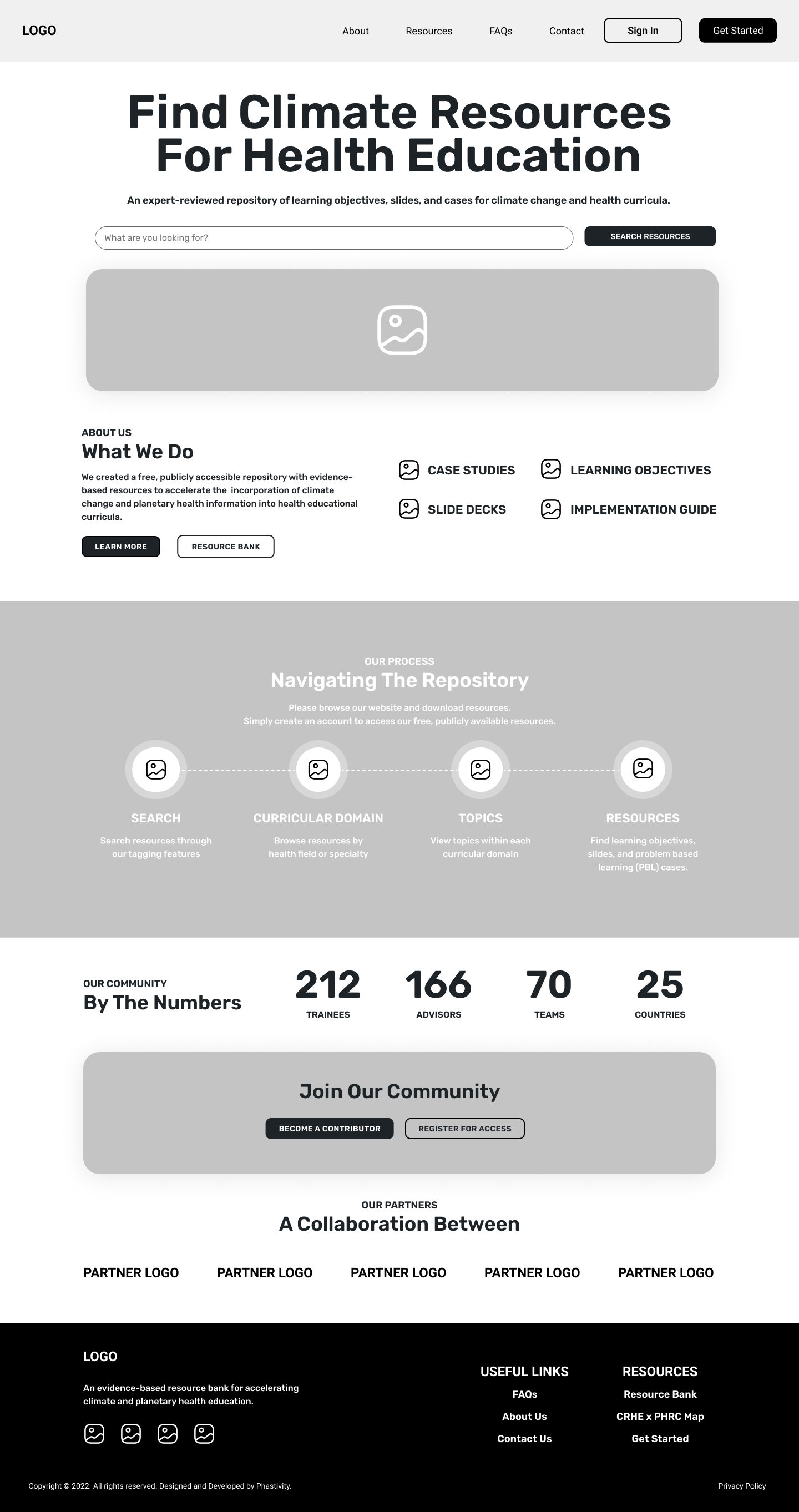
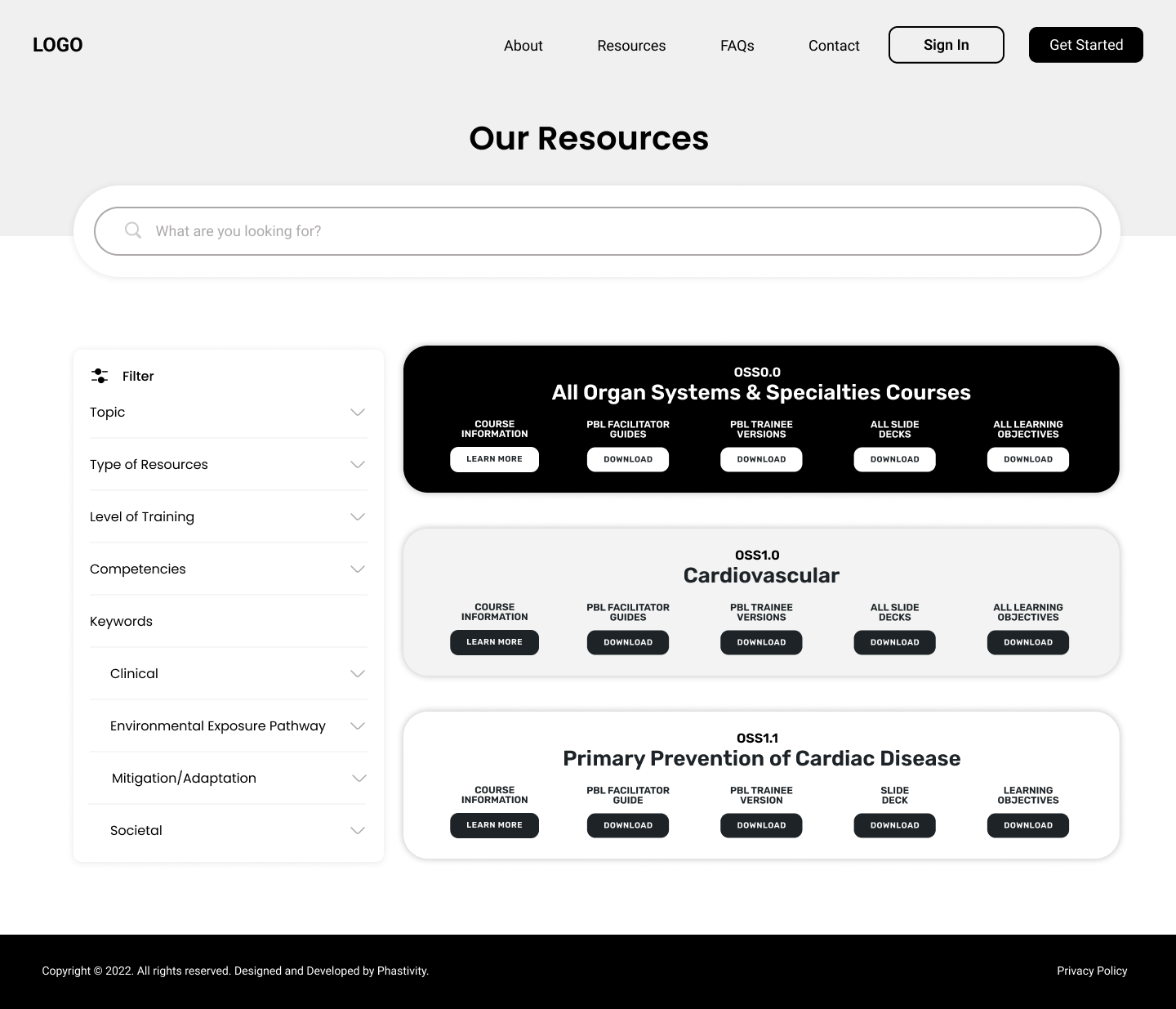
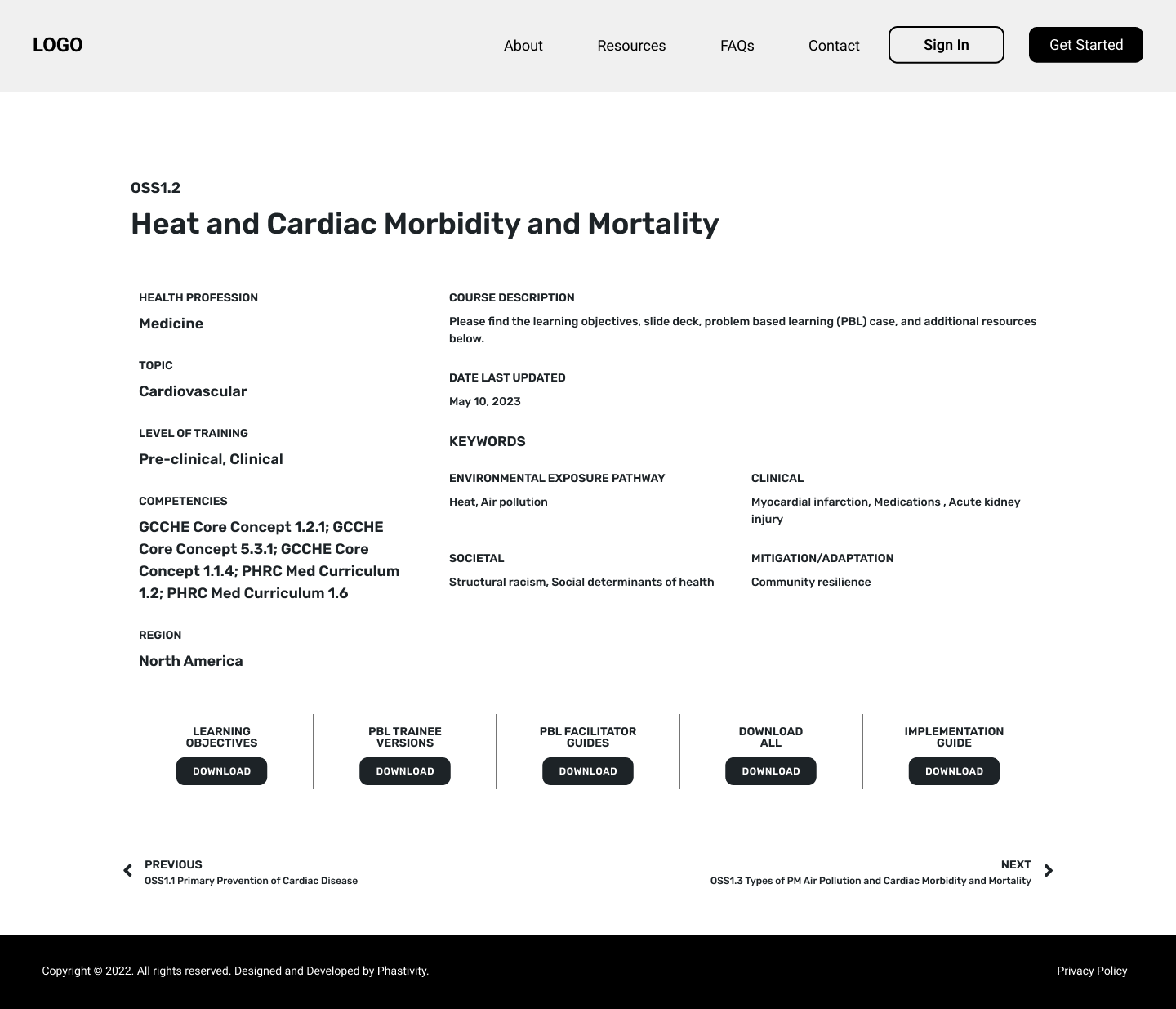
Usability Testing
Develop
Usability Test Plan
Conducting Usability Testing
Affinity Map

Observation Patterns
Insight
Recommendation
UPDATES TO WIREFRAMES
Before

After

Mood Board
Deliver
To gather inspiration for CRHE, I created a mood board in Adobe Illustrator. I curated a selection of images that encapsulate the key attributes identified from our product goals and features. The goal was to keep the number of attributes minimal, ensuring that CRHE’s brand stands out distinctly.
Nature and Environment: Include images and visuals that evoke a sense of nature, sustainability, and the environment. This can include landscapes, plants, animals, and natural elements.
Health and Wellness: Incorporate visuals that represent health, well-being, and the connection between the environment and human health. This can include images of people engaged in physical activities, healthy food, and scenes that promote a sense of well-being.
Education and Learning: Include visuals that reflect the educational aspect of CRHE. This can include images of classrooms, students, books, learning materials, and educational settings.
Collaboration and Community: Incorporate visuals that represent collaboration, networking, and community engagement. This can include images of people working together, group discussions, hands joining, and diverse communities.
Technology and Innovation: Include visuals that showcase the use of technology and innovation in the context of climate change and health. This can include images of digital devices, data visualization, futuristic concepts, and cutting-edge solutions.
Empathy and Compassion: Incorporate visuals that evoke empathy, care, and compassion for others and the environment. This can include images of people helping each other, acts of kindness, and moments of connection.
Colors and Typography: Consider the color palette and typography that align with the brand identity of CRHE. Choose colors and fonts that convey the desired mood and tone, such as calming and earthy tones for nature-related themes, and clear and legible typography for educational content.
Logo and Icon
Deliver
Style Tile
Deliver
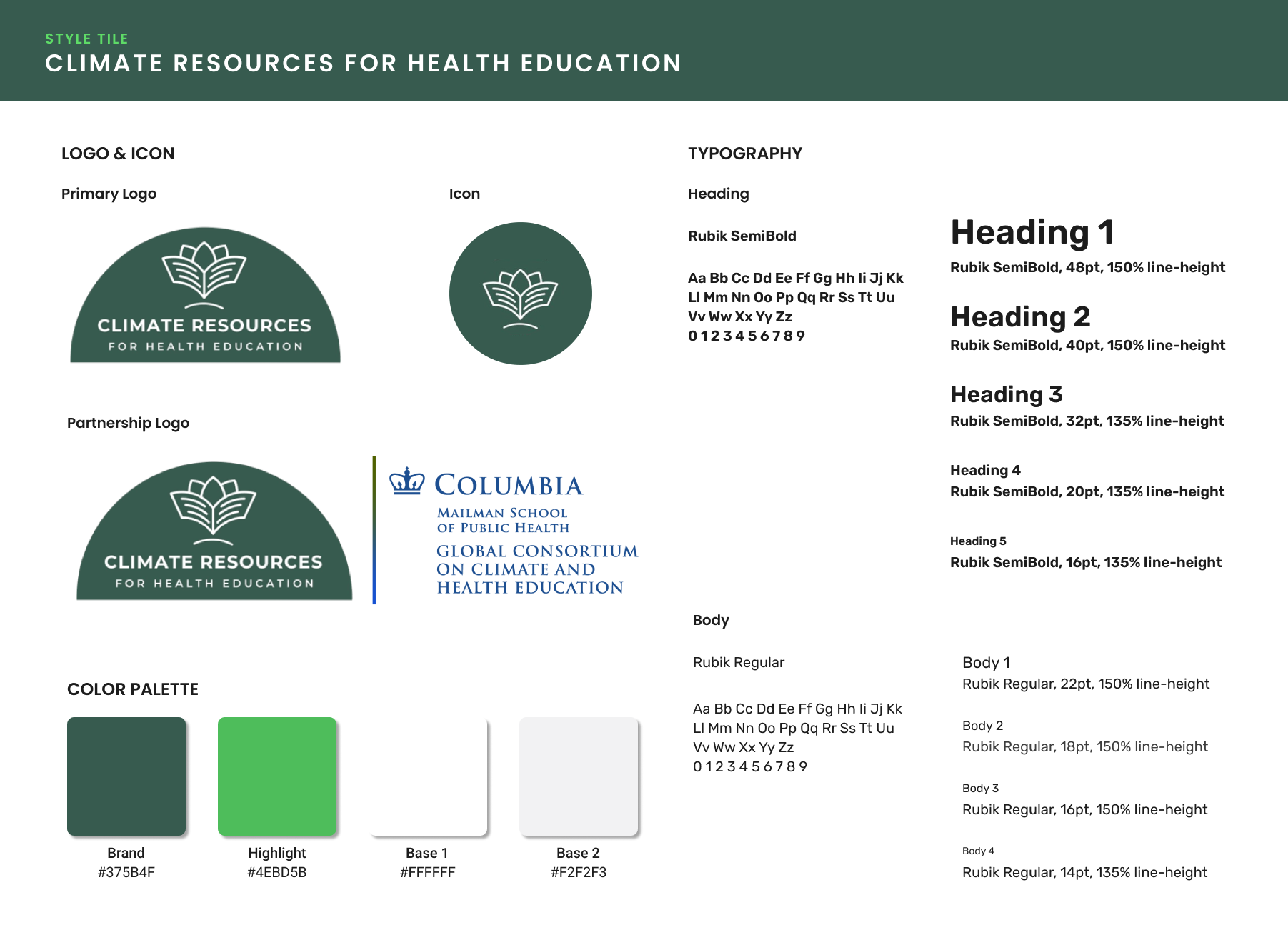
UI Kit
Deliver
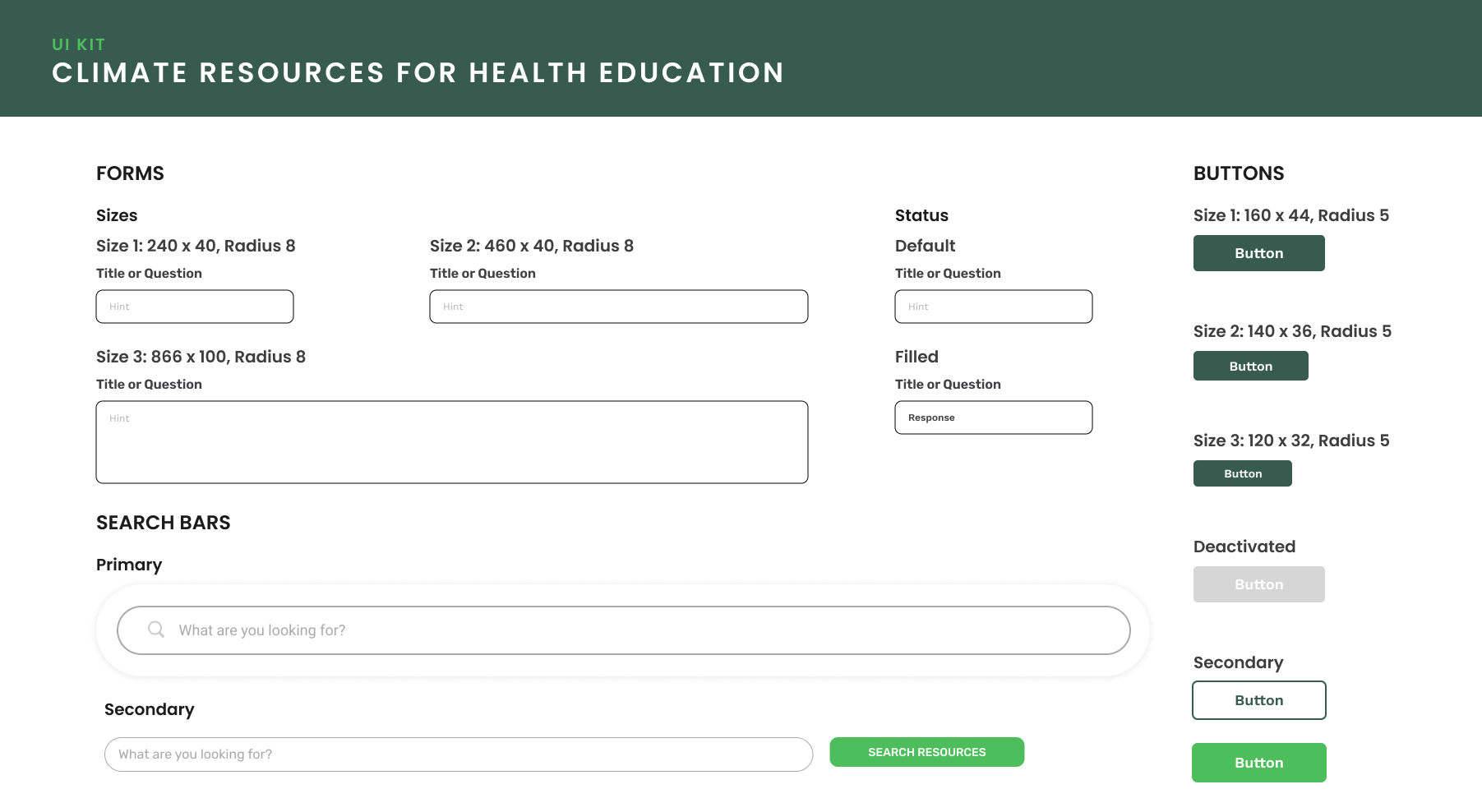
High-Fidelity Wireframe and Prototype
Deliver
High-Fidelity Wireframe

Final Thoughts
Reflections and Beyond
Next Steps
With the completion of the project, it is crucial to consider the next steps for CRHE. Here are some recommended actions:
Content Expansion: Continuously curate and expand the collection of peer-reviewed resources to provide a comprehensive and up-to-date repository of climate and health information. This can involve partnerships with academic institutions, research organizations, and subject matter experts.
User Engagement: Implement features that encourage user engagement and interaction, such as discussion forums, user-generated content, and community-driven initiatives. This fosters collaboration, knowledge sharing, and networking among educators and health professionals.
Analytics and Feedback: Incorporate analytics tools to gather user data and insights. Analyze user behavior, preferences, and feedback to identify areas for improvement and make data-driven decisions for enhancing the website’s functionality and content.
Outreach and Partnerships: Develop a marketing and outreach strategy to increase awareness and adoption of CRHE. Collaborate with relevant organizations, attend conferences and events, and leverage social media platforms to reach a broader audience of educators and health professionals.
Maintenance
To ensure the long-term success of CRHE, ongoing maintenance is crucial. This includes:
Regular Updates and Bug Fixes: Monitor the website for any issues, bugs, or broken links, and promptly address them to maintain a seamless user experience. Regularly update software and security measures to ensure data protection.
Content Review and Quality Assurance: Conduct periodic reviews of the resources to ensure they meet rigorous quality standards and reflect the latest research and best practices in the field of climate and health.
Accessibility Compliance: Regularly assess and enhance the website’s accessibility to ensure it meets or exceeds accessibility standards, enabling users with disabilities to access and navigate the content effectively.
User Support and Communication: Establish channels for user support, such as a dedicated support email or chat, to address inquiries, aid, and gather feedback. Actively communicate updates, new features, and relevant information through newsletters or blog posts.
By prioritizing these next steps and implementing effective maintenance practices, CRHE can continue to evolve as a trusted and valuable resource for educators and health professionals, contributing to the advancement of climate and health education.
Other Case Studies
AGAPE ACTS
HEALTH AND CLIMATE HUB
DURATION
Project Scope
18 weeks (720 hours)
Application and Branding
DURATION
Project Scope
Website and Branding
AGAPE ACTS
DURATION
(720 hours)
Project Scope
Application, Website, and Branding
HEALTH AND CLIMATE HUB
DURATION
(328 hours)

